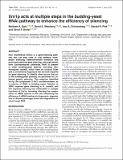Xrn1p acts at multiple steps in the budding-yeast RNAi pathway to enhance the efficiency of silencing
Author(s)
Getz, Matthew Aaron; Weinberg, David E.; Drinnenberg, Ines A.; Fink, Gerald R; Bartel, David
DownloadPublished version (6.357Mb)
Publisher with Creative Commons License
Publisher with Creative Commons License
Creative Commons Attribution
Terms of use
Metadata
Show full item recordAbstract
© 2020 The Author(s) 2020. Published by Oxford University Press on behalf of Nucleic Acids Research. RNA interference (RNAi) is a gene-silencing pathway that can play roles in viral defense, transposon silencing, heterochromatin formation and post-transcriptional gene silencing. Although absent from Saccharomyces cerevisiae, RNAi is present in other budding-yeast species, including Naumovozyma castellii, which have an unusual Dicer and a conventional Argonaute that are both required for gene silencing. To identify other factors that act in the budding-yeast pathway, we performed an unbiased genetic selection. This selection identified Xrn1p, the cytoplasmic 5′-to-3′ exoribonuclease, as a cofactor of RNAi in budding yeast. Deletion of XRN1 impaired gene silencing in N. castellii, and this impaired silencing was attributable to multiple functions of Xrn1p, including affecting the composition of siRNA species in the cell, influencing the efficiency of siRNA loading into Argonaute, degradation of cleaved passenger strand and degradation of sliced target RNA.
Date issued
2020Department
Massachusetts Institute of Technology. Department of Biology; Whitehead Institute for Biomedical Research; Howard Hughes Medical InstituteJournal
Nucleic Acids Research
Publisher
Oxford University Press (OUP)